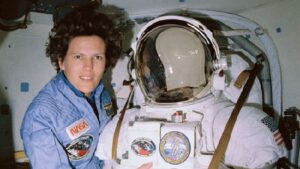On October 11, 1984, American astronaut Kathryn Sullivan made history by becoming the first woman to walk in space. This monumental achievement not only marked a significant milestone in her career but also represented a broader triumph for women in science, technology, engineering, and mathematics (STEM) fields.
Background and Early Life
Kathryn Sullivan was born on November 3, 1951, in Pasadena, California. She developed a fascination with science and exploration at an early age, eventually earning a Bachelor of Arts degree in geography from the University of California, Santa Barbara, and a Ph.D. in geology from Dartmouth College. Her educational background laid a strong foundation for her future career as an astronaut and scientist.
Sullivan joined NASA in 1978 as part of the agency’s first class of female astronauts. This class included six women, breaking the traditional gender barriers that had previously limited female representation in space exploration. As a mission specialist, Sullivan quickly distinguished herself through her expertise and dedication.
The STS-41-G Mission
Kathryn Sullivan’s historic spacewalk occurred during the Space Shuttle Challenger’s STS-41-G mission. Launched on October 5, 1984, the mission aimed to conduct various scientific experiments and deploy satellites. Sullivan was part of a diverse crew, which included fellow astronauts David Leestma, Charles D. Gemar, and others.
On October 11, 1984, during the fourth day of the mission, Sullivan and her fellow astronaut, David Leestma, conducted a spacewalk that lasted approximately 3 hours and 29 minutes. During this time, they performed critical tasks outside the shuttle, including the installation of equipment and the deployment of experiments.
A Historic Achievement
As Sullivan stepped out of the airlock of the Space Shuttle Challenger, she became the first woman to walk in space, a moment that garnered significant media attention and public acclaim. Her accomplishment symbolized the breaking of gender barriers in a field that had been historically dominated by men.
During the spacewalk, Sullivan conducted various tasks while showcasing her expertise and professionalism. She demonstrated the capabilities of women in science and engineering, inspiring a new generation of girls and young women to pursue careers in STEM fields.
The Legacy of Kathryn Sullivan
Kathryn Sullivan’s achievement was not only significant for her personally but also represented a turning point for women in aerospace and scientific careers. Her spacewalk challenged stereotypes and demonstrated that women could excel in demanding and high-stakes environments.
In the years following her historic walk, Sullivan continued to break barriers. She flew on three space shuttle missions, conducting research in areas such as Earth science and oceanography. After retiring from NASA, she took on various leadership roles, including serving as the Administrator of the National Oceanic and Atmospheric Administration (NOAA).
Inspiring Future Generations
Sullivan’s legacy extends beyond her individual accomplishments; it serves as a powerful reminder of the importance of representation and diversity in STEM fields. By breaking through barriers and achieving historic milestones, she has inspired countless individuals to pursue their passions in science and exploration.
Today, Kathryn Sullivan is often invited to speak about her experiences and the importance of encouraging young women to engage in STEM. Her story continues to motivate and empower future generations, emphasizing that with determination and hard work, anyone can achieve greatness, regardless of gender.
Conclusion
The historic spacewalk of Kathryn Sullivan on October 11, 1984, marked a significant milestone in the journey toward gender equality in space exploration and the broader STEM fields. As the first woman to walk in space, Sullivan’s achievement symbolizes the breaking of barriers and the possibilities that lie ahead for future generations. Her contributions to science, exploration, and education continue to resonate, inspiring others to dream big and reach for the stars.












What do you think?
It is nice to know your opinion. Leave a comment.